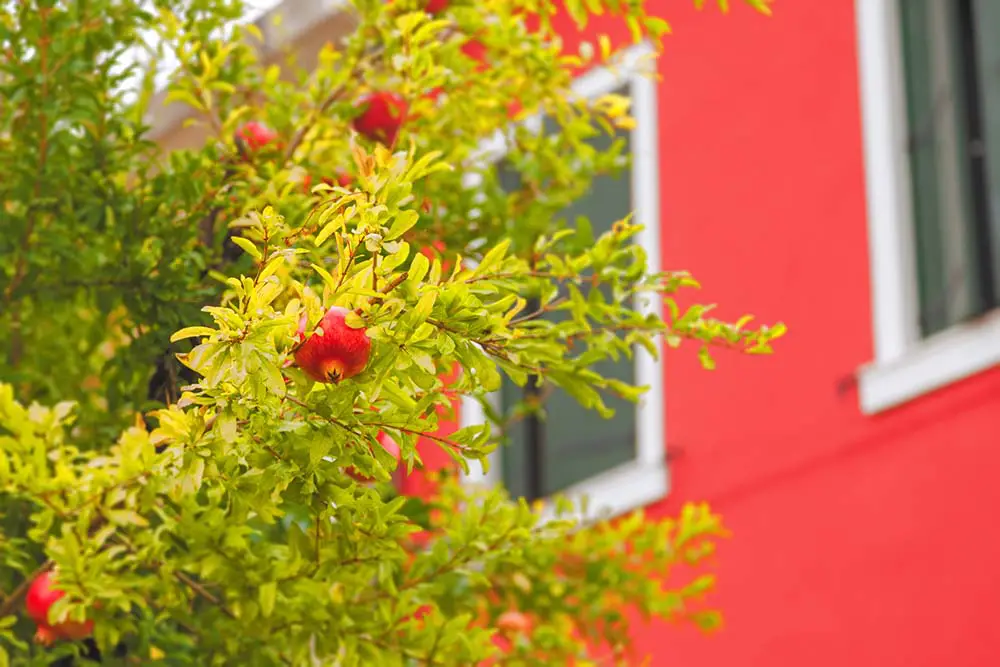
We may receive commissions from purchases made through links in this post, at no additional cost to you.
Planting a new fruit tree is a commitment – you have to invest time, money, effort, and precious garden space in the hopes that it will provide you fruit for a long time. Pomegranate trees are definitely worth that investment. They’re productive, hardy, long-lived, and relatively low-maintenance.
Most of us don’t have tons of space in our gardens for huge fruit trees, even one as ornamental and fruitful as a pomegranate tree. So how much space does a pomegranate tree need? How tall will it get, and how do you go about controlling its size?
Most pomegranate trees grow to be 8 to 15 feet tall, with a spread of 6 to 12 feet. Depending on the variety, however, the height could range from 2 feet to more than 30 feet. Pomegranate trees grow 1 to 2 feet per year, and they can be kept smaller with regular pruning.
There’s a reason pomegranate trees are increasing in popularity in home gardens. As you decide whether to plant one (or which variety to choose), read on to learn all about pomegranate tree size, basic pruning techniques, and a few pomegranate varieties that will fit any backyard or patio space.
Pomegranate Tree Size
Pomegranate trees naturally grow as multi-stemmed shrubs, frequently sending up new shoots from the base of the plant. Because of this, they tend to grow nearly as wide as they do tall. Picture the shape of a vase – narrower at the bottom and widening to the top.
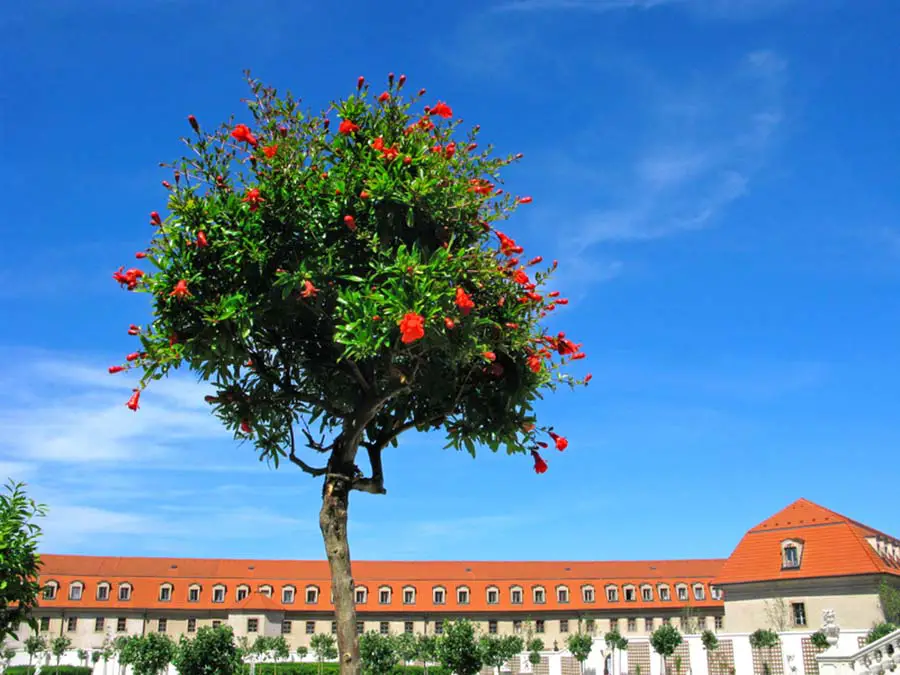
It’s fairly common to choose one of the shoots and prune away the rest, leaving the pomegranate to grow as a single-stemmed tree. Training a pomegranate tree this way tends to be more work in the first few years, but will become easier as the tree matures. A single-stemmed tree takes up less space in the garden, although it may grow taller than the shrub form.
It’s tricky to predict the height of a pomegranate tree because it depends largely on pruning habits. Most pomegranate trees grow to be 8 to 15 feet tall, but regular pruning will keep the size in check (more on this below). Some varieties are natural dwarfs that will stay under 10 feet, while others left unchecked would grow to be 20 feet or more.
How fast does a pomegranate tree grow?
Pomegranate trees are vigorous growers, especially when they are young. The first several seasons, a pomegranate tree will grow 1 to 2 feet per year. As the tree matures, its growth rate will slow somewhat.
New shoots constantly form at the base of the plant and need to be trimmed regularly. Pomegranate trees fruit on short spurs that remain productive for several years. In the spring, new growth emerges mostly at the tips of last year’s branches. This new growth becomes the new fruiting wood.
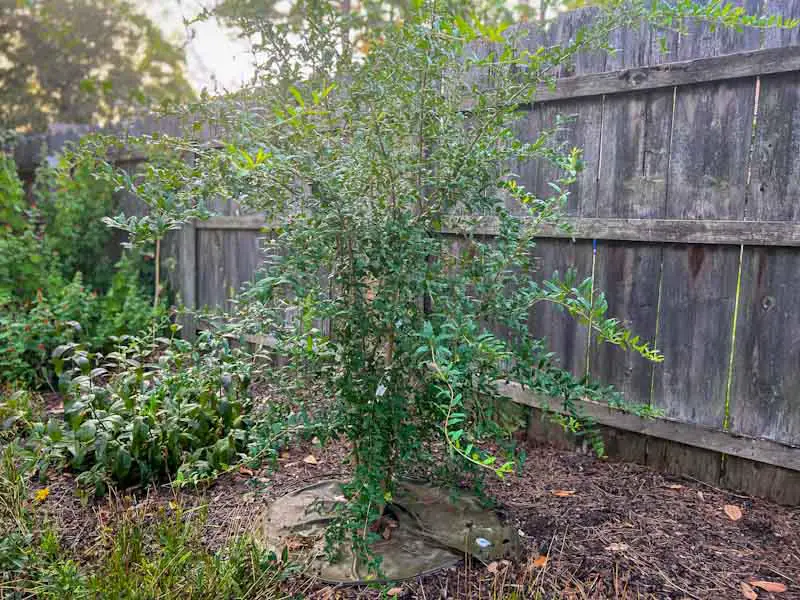
Young pomegranate trees won’t produce their first crop of fruit until they are 2 to 3 years old. A few pomegranates may show up in the first couple of years, but they’ll be small and underdeveloped since the tree is using most of its energy to establish a root system.
Once fruiting begins in earnest around year 4 or 5, the tree will continue producing heavily until it is about 25 years old. At that point, productivity will begin to slow as the tree ages.
Related: Perfect Timing: When Does a Pomegranate Tree Bloom and Fruit?
Each year as the tree grows larger, the harvest gets bigger. A 4- or 5-year-old tree will support about 10 pounds of fruit (15-25 pomegranates, depending on how big). But a full-grown, mature pomegranate tree can produce up to 200 pomegranates per season!
The Long Life of a Pomegranate Tree
As you would expect, the older a pomegranate tree gets, the bigger it grows – to a point. As the tree gets older its fruit production slows, and the size and flavor of the fruit may decline over time. Anecdotally, however, a happy pomegranate tree can keep producing delicious fruit for 30 or 40 years.
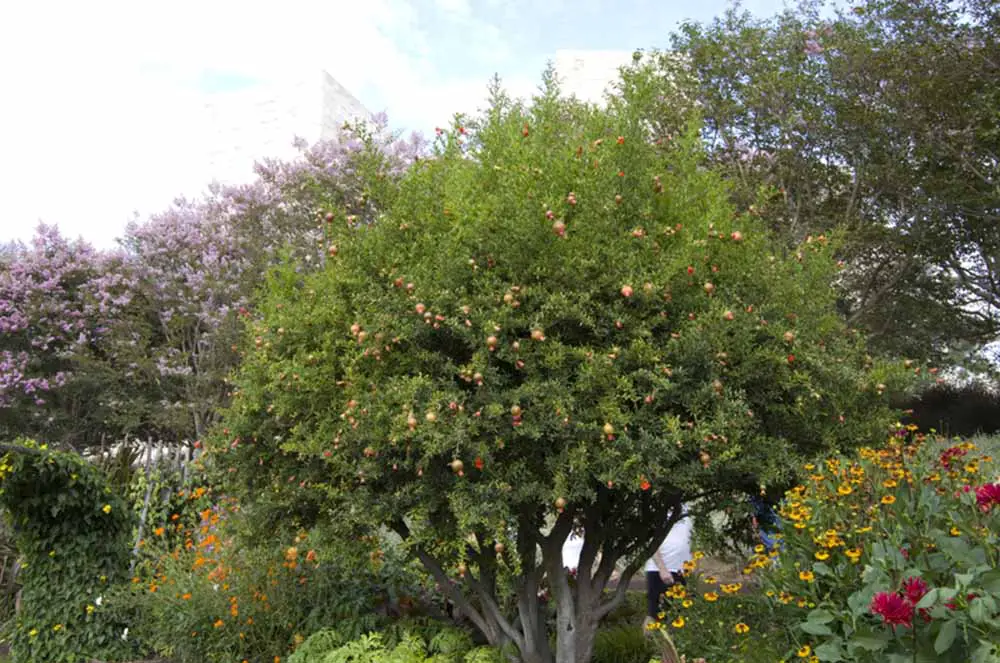
Pomegranate trees will live many years beyond their fruiting life. Commercial pomegranate farms typically only keep the trees for 15-20 years, since after that their fruit production declines and they become less economically viable. But pomegranate trees have been known to survive for over 200 years in the right growing conditions.
Learn more: The Lifespan of a Pomegranate Tree (Decades of Fruit!)
Pomegranates are one of the ancient cultivated crops of the world. They originated in Western and Central Asia (there’s debate as to exactly where). Pomegranates were an important part of the culture of many ancient civilizations, whether as a part of the diet or simply as decoration.
How to Control Pomegranate Tree Size
It’s easy to control the size of a pomegranate tree with regular pruning. Even if the tree could grow as tall as 15 to 20 feet, you can keep it trimmed to a height where you can easily reach all of the fruit. Expect to prune the tree every year, however, if you want to keep its size in check.
I wrote a separate article with all of the pomegranate pruning details you’ll ever need, which you can find here: Pruning Pomegranate Trees: An Easy Guide for Home Growers. This article goes into exactly when to prune (and when not to), how to make different pruning cuts, what the benefits are (bigger and better fruit!), and pruning pitfalls to avoid.
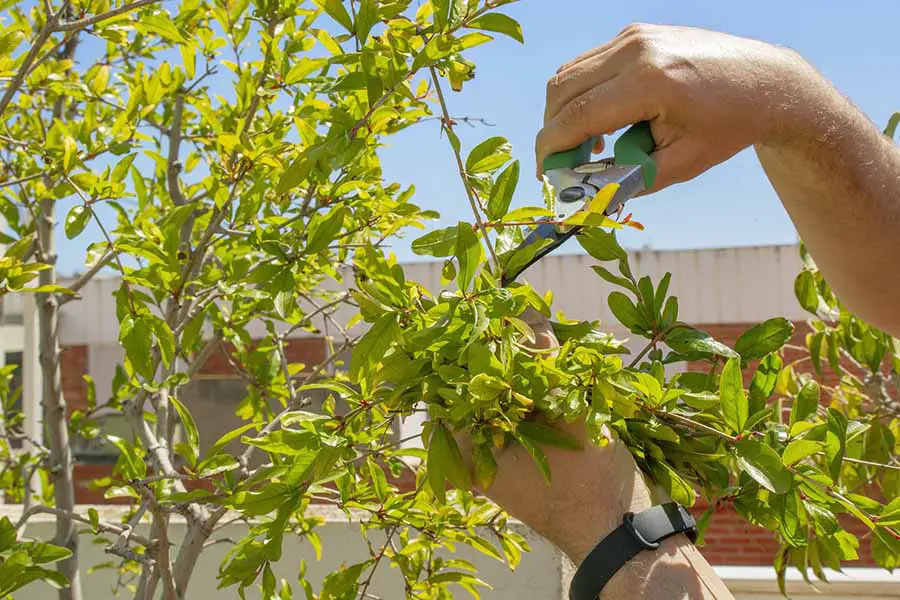
Check out the above article for more specifics, but in the meantime, here are the basics of pruning to control pomegranate tree size:
- The first winter after planting (or in early spring before new growth starts), select 4-6 strong shoots to keep as the main structure of the bush. Trim the rest of the shoots to ground level. (To train into a tree, choose one main trunk and remove the rest. Cut the trunk to about 2-3 feet to encourage branching.)
- Shorten the remaining shoots by about 1/3.
- Each year during the dormant season, shorten branches by about 1/3 (up to 1/2 if they are really long) to encourage branching and the growth of new fruiting wood.
- After several years, cut any old, declining fruiting shoots down to the ground and allow a new shoot to grow up and replace it.
- Always remove extra root suckers as they appear any time during the growing season.
- Once the main form of the shrub or tree is established, it should only need light pruning every year. Concentrate on removing dead growth, root suckers, and shortening long branches by 1/3.
Smallest Pomegranate Tree Varieties
The other way to control pomegranate tree size is to simply choose a naturally smaller variety. Dwarf pomegranate trees range from 3 to 10 feet and can fit into just about any garden space.
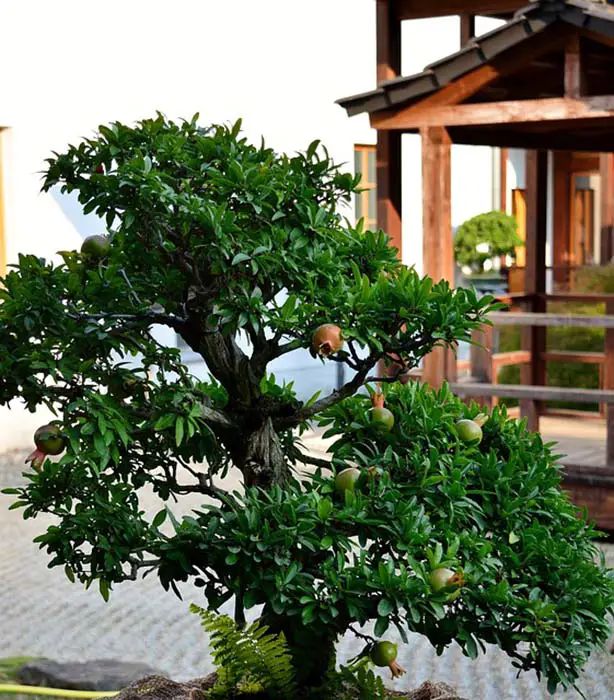
You can also plant just about any pomegranate variety in a pot, as they have relatively shallow roots. Potted pomegranate trees will naturally stay a little smaller than those planted in the ground because their roots are restricted by the container. Just be sure the tree is placed in a spot that gets at least 6 hours of sunlight, and water it regularly during the fruiting season.
Here are some of the best compact pomegranate tree varieties:
- ‘Red Silk’ – This is a very productive compact shrub that is tolerant to heat and humidity. It grows medium-sized fruits with red skin and contrasting yellow-gold arils. The flavor of ‘Red Silk’ pomegranates is reminiscent of a berry – mildly sweet with slight tartness. Grows up to 6 feet tall and is tolerant of heavy pruning.
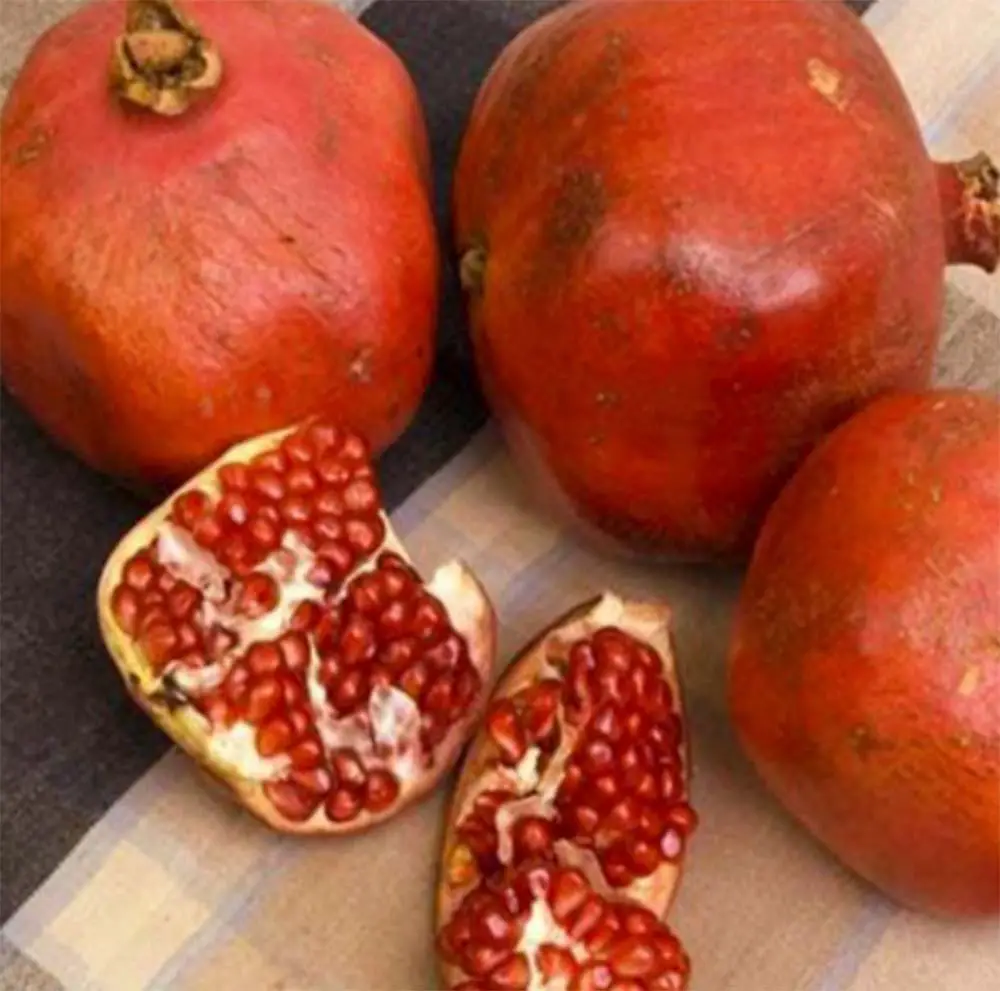
- ‘Salavatski’ – Also called ‘Russian Red’ or ‘Russian Turk’, ‘Salavatski’ is a very cold hardy pomegranate that could even be grown in zone 6 (typically zones 7-10). It grows large fruit with orange-red skin and deep red arils with crunchy seeds. Great for juicing. Grows up to 10 feet.
- ‘Dwarf Red’ – This pomegranate variety is also called ‘Nana.’ It is a true dwarf that will stay under four feet even if never pruned. ‘Nana’ is easy to maintain as small as 2 to 3 feet, and it is often grown as a bonsai tree. It has showy red blooms and small, deep red fruits. The fruit is edible but is more tart than large pomegranates, so ‘Dwarf Red’ is often grown as an ornamental.
- ‘Angel Red’ – ‘Angel Red’ will grow up to 10 feet tall in the ground, but is easy to keep smaller. It’s a heavy producer of bright pinkish red fruits with juicy, bright red, soft arils that are perfectly sweet-tart. ‘Angel Red’ will often fruit in its first year or two. The blossoms are orange-red, and the fruits are ready to harvest in the late fall.
- ‘Eversweet’ – Just like its name sounds, ‘Eversweet’ grows pomegranates with high sugar content and not much acidity (which makes them taste less “pomegranate-y”). The arils are dark pink with hard seeds – ideal for juicing. The tree grows 8 to 10 feet tall and is ready for harvest in late September/early October.
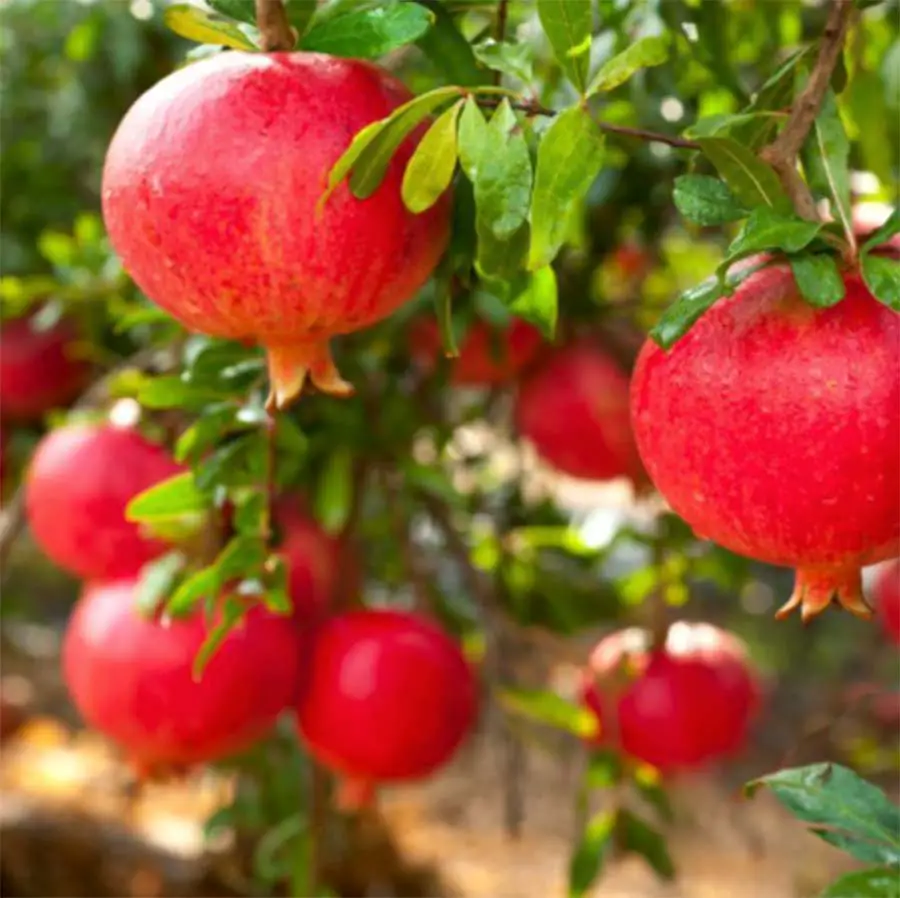
- ‘Parfianka’ – This is one of the most popular pomegranate varieties for home gardeners. ‘Parfianka’ is a natural dwarf, growing up to 10 feet tall. It produces a heavy crop of large, bright reddish-yellow fruits with almost black-red, juicy, soft-seeded arils. It’s perhaps one of the best-tasting pomegranate varieties, with a sweet and tart flavor that leans slightly more to the sweet side.
- ‘Ariana’ – ‘Ariana’ is another one of the best-tasting varieties. It grows a ton of medium-to-large fruits with bright red skin and dark red arils. ‘Ariana’ has very tiny, almost unnoticeable seeds, so it’s great for fresh eating or juicing. Ripens in late fall. Zone 7-10.
For even more great pomegranate cultivars to grow at home, check out: Choosing the Perfect Pomegranate Tree (19 Top Varieties)

